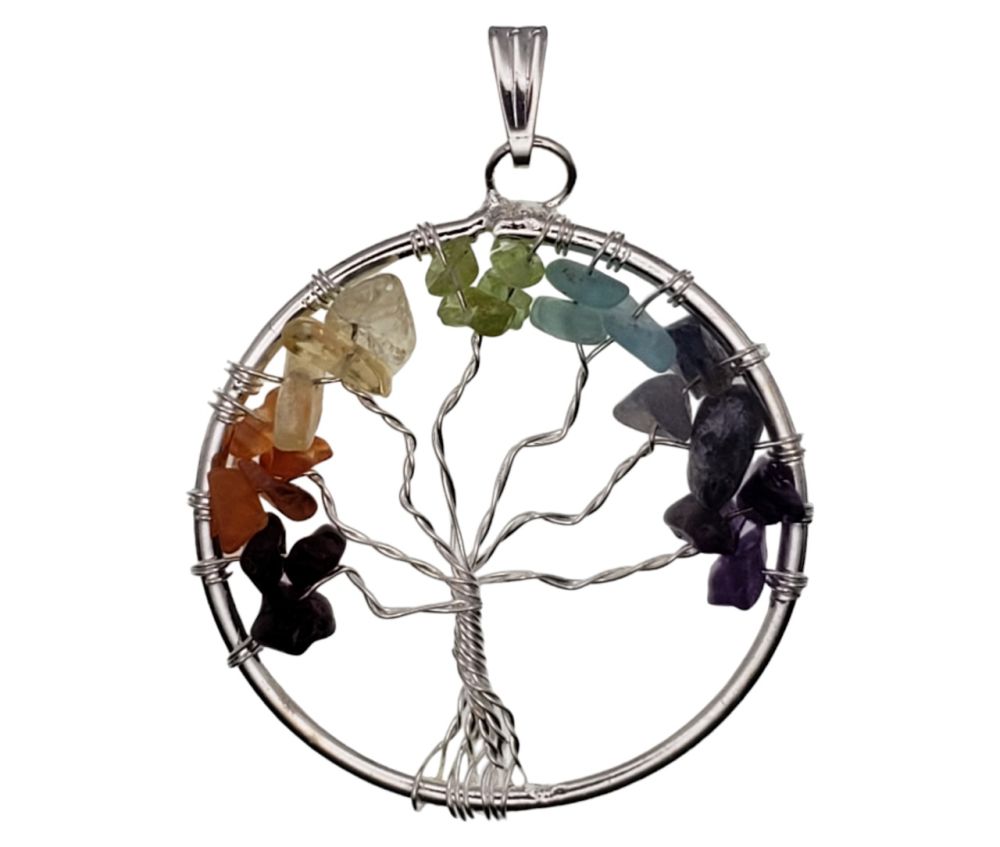We use cookies to make your experience better.
TimmersGems has a new website, existing customers also need to register again.
Chakra tree of life pendant in silver color.
According to some sources, the most produced pendant in India! All real gemstones at a super competitive price!
Availability:
In stock
SKU
120761
- Buy 10 for €2.99 each and save 25%
- Buy 25 for €2.40 each and save 40%
Chakra tree of life pendant in silver color. is available to buy in increments of 3
The Biblical tree of life or tree of life (Hebrew: עץ החיים; Etz haChayim) is mentioned in the Bible book of Genesis in verse 2:9 as the tree that, together with the tree of the knowledge of good and evil, was planted by God in the Garden of Eden (Paradise) and whose fruits give eternal life (immortality). After Adam and Eve ate from the tree of the knowledge of good and evil, the Bible records that both were banished from the Garden of Eden to keep them from eating the fruit of the tree of life: “Then God thought , the LORD: Now man has become like us, and he has knowledge of good and evil. Now I will prevent him from gathering the fruit of the tree of life, for if he eats it, he will live forever." — (NIV, Gen 3:22), According to the Bible story, Adam and Eve were thus separated from the tree of life and made mortal. In the Christian New Testament, this banishment from the Garden of Eden is compensated by the 'planting' of the new tree of life (Jesus) on the side of man. In the Book of Revelation of John, the Koinè Greek phrase xylon zoës (ξύλον ζωής) is used three times (2:7, 22:2 and 22:19), which in Dutch translations literally means 'tree of life' or 'tree of life' translated (22:19 is also translated as 'book of life' in some translations). The 'tree of life' is used several times in the Bible book of Proverbs in connection with Wisdom. As an image it describes the value of Wisdom. Wisdom is a tree of life for those who embrace it (Prov. 3:18). A righteous man plants a tree of life (Prov. 11:30). Fulfilled desire (as opposed to unfulfilled hope) is a tree of life (Prov. 13:12). Calm words (as opposed to a false tongue) are a tree of life (Prov. 15:4). The writer of Proverbs seems to show a preference for the image of the tree of life, but it is nowhere explicitly stated. The image as such probably has sufficient expressive power for the writer. The tree of life is depicted in several examples of sacred geometry and is a central point in Kabbalah (the mystical study of the Torah), where it is represented as the sefirot. The Germanic tree of life. The Irminsul was an important sanctuary for the Saxons of the eighth century AD. with probably great symbolic significance. It is mentioned and briefly described in the Annales regni Francorum, the Translatio St. Alexandri by Rudolf of Fulda and in the Gesta Hammaburgensis ecclesiae pontificum (Book I, chapter 8) by Adam of Bremen. The latter two use exactly the same words and describe the Irminsul as a large, erect wooden trunk that, according to the Saxons, supported the entire world. However, Adam van Bremen says that he took over the data from Einhard (ca 770-841). However, his work has not been preserved. In Einhard's words according to Adam van Bremen: Truncum quoque ligni non parvae magnitudinis in altum erectum sub divo colebant, patria eum lingua Irminsul appellantes, quod Latine dicitur universalis columpna, quasi sustinens omnia. Translated this means: They also used to worship a wooden trunk of no small size, raised high under the open sky, which they called in the language of their native land Irminsul, which in Latin becomes universalis columna (= all-pillar). mentioned, which, as it were, supported everything. The Kabbalistic Tree of Life is a model with which Hermetic Kabbalists symbolically represent the entire universe and its origins. This tree of life has a different shape than the one known to the Jewish Kabbalists. The first publication in which this tree of life appeared was Athanasi Kircher's Oedipus Aegypticus from 1652. Robert Fludd copied this diagram in an adapted form in his Complete Works from 1617.
| Dimensions | 40mm |
|---|---|
| Country of Manufacture | India |












